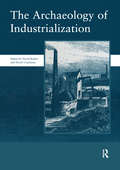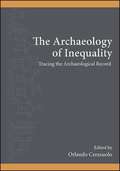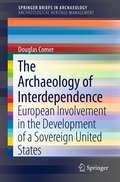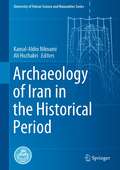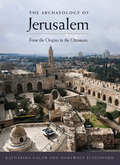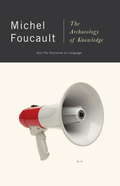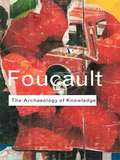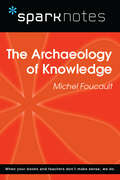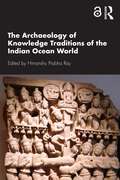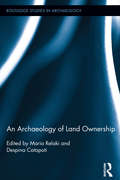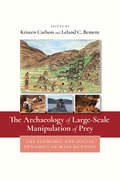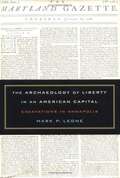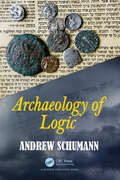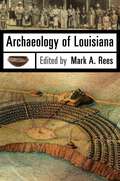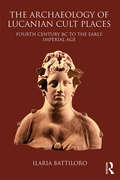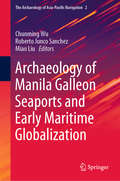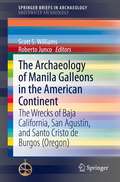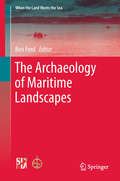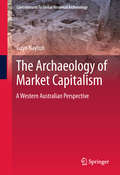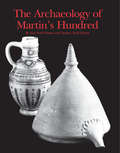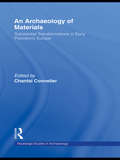- Table View
- List View
The Archaeology of Industrialization: Society of Post-Medieval Archaeology Monographs (The\society For Post-medieval Archaeology Monographs #Vol. 2)
by David Barker David CranstoneThis book is the outcome of the first joint conference of the two country's foremost societies devoted to the archaeological study of the early-modern and modern worlds. It discusses the progress of industrialization and its impact upon modern society.
The Archaeology of Inequality: Tracing the Archaeological Record (SUNY series, The Institute for European and Mediterranean Archaeology Distinguished Monograph Series)
by Orlando CerasuoloThe Archaeology of Inequality explores the different aspects of social boundaries and articulation by comparing several interdisciplinary approaches for the analysis of the archaeological data, as well as actual case studies from the Prehistory to the Classical world. The book explores slavery, gender, ethnicity and economy as intersecting areas of study within the larger framework of inequality and exemplifies to what degree archaeologists can identify and analyze different patterns of inequality.
The Archaeology of Interdependence
by Douglas C. ComerThe publication explores the ways in which archaeological research can inform us about the manner and motives of European involvement in the development of a sovereign United States. The five chapters focus on different archaeological sites (four terrestrial sites and one underwater), and each consider the special ways in which archaeology can contribute to our understanding of the cultural dynamics that set the historic course of events in motion that culminated in United States sovereignty. An introduction and conclusion examine how the material culture that is the central focus of archaeological research should be preserved, managed, and interpreted. While much is known through historical documents, this volume seeks to enrich, modify, and challenge the written record by attention to the archaeological remains. The scale of analysis ranges from the artifact through the site to the landscape. Chapters address the changing relationships between specific European countries and the United States as indicated by the presence of artifacts or types of artifacts (e.g., weapons, domestic, architectural) made or traded by other countries during different time periods; an analysis of "space syntax" seen at battlefields or fortifications; the importance of conceptually reconstructing terrain crossed by troops or at battlefields. The Archaeology of Interdependence: European Involvement in the Development of a Sovereign United States presents innovative investigations of what material culture at all scales might tell us about the political, economic, or ideological relationships among cultures that corroborates, contradicts, or enriches the historic record.
The Archaeology of Iran from the Palaeolithic to the Achaemenid Empire: From The Palaeolithic To The Achaemenid Empire (Routledge World Archaeology)
by Roger Matthews Hassan Fazeli NashliThe Archaeology of Iran from the Palaeolithic to the Archaemenid Empire is the first modern academic study to provide a synthetic, diachronic analysis of the archaeology and early history of all of Iran from the Palaeolithic period to the end of the Achaemenid Empire at 330 BC. Drawing on the authors’ deep experience and engagement in the world of Iranian archaeology, and in particular on Iran-based academic networks and collaborations, this book situates the archaeological evidence from Iran within a framework of issues and debates of relevance today. Such topics include human–environment interactions, climate change and societal fragility, the challenges of urban living, individual and social identity, gender roles and status, the development of technology and craft specialisation and the significance of early bureaucratic practices such as counting, writing and sealing within the context of evolving societal formations. Richly adorned with more than 500 illustrations, many of them in colour, and accompanied by a bibliography with more than 3000 entries, this book will be appreciated as a major research resource for anyone concerned to learn more about the role of ancient Iran in shaping the modern world.
Archaeology of Iran in the Historical Period (University of Tehran Science and Humanities Series)
by Kamal-Aldin Niknami Ali HozhabriThis collection of twenty-eight essays presents an up-to-date survey of pre-Islamic Iran, from the earliest dynasty of Illam to the end of Sasanian empire, encompassing a rich diversity of peoples and cultures. Historically, Iran served as a bridge between the earlier Near Eastern cultures and the later classical world of the Mediterranean, and had a profound influence on political, military, economic, and cultural aspects of the ancient world. Written by international scholars and drawing mainly on the field of practical archaeology, which traditionally has shared little in the way of theories and methods, the book provides crucial pieces to the puzzle of the national identity of Iranian cultures from a historical perspective. Revealing the wealth and splendor of ancient Iranian society – its rich archaeological data and sophisticated artistic craftsmanship – most of which has never before been presented outside of Iran, this beautifully illustrated book presents a range of studies addressing specific aspects of Iranian archaeology to show why the artistic masterpieces of ancient Iranians rank among the finest ever produced. Together, the authors analyze how archaeology can inform us about our cultural past, and what remains to still be discovered in this important region.
The Archaeology of Japan:
by Koji MizoguchiThis is the first book-length study of the Yayoi and Kofun periods of Japan (c. 600 BC - 700 AD), in which the introduction of rice paddy-field farming from the Korean peninsula ignited the rapid development of social complexity and hierarchy that culminated with the formation of the ancient Japanese state. The author traces the historical trajectory of the Yayoi and Kofun periods by employing cutting-edge sociological, anthropological, and archaeological theories and methods. The book reveals a fascinating process through which sophisticated hunting-gathering communities in an archipelago on the eastern fringe of the Eurasian continent were transformed materially and symbolically into a state.
The Archaeology of Jerusalem
by Hanswulf Bloedhorn Katharina GalorIn this sweeping and lavishly illustrated history, Katharina Galor and Hanswulf Bloedhorn survey nearly four thousand years of human settlement and building activity in Jerusalem, from prehistoric times through the Ottoman period. The study is structured chronologically, exploring the city's material culture, including fortifications and water systems as well as key sacred, civic, and domestic architecture. Distinctive finds such as paintings, mosaics, pottery, and coins highlight each period. Their book provides a unique perspective on the emergence and development of Judaism, Christianity, and Islam, and the relationship among the three religions and their cultures into the modern period.
The Archaeology of Knowledge
by Michel FoucaultIn France, a country that awards its intellectuals the status other countries give their rock stars, Michel Foucault was part of a glittering generation of thinkers, one which also included Sartre, de Beauvoir and Deleuze. One of the great intellectual heroes of the twentieth century, Foucault was a man whose passion and reason were at the service of nearly every progressive cause of his time. From law and order, to mental health, to power and knowledge, he spearheaded public awareness of the dynamics that hold us all in thrall to a few powerful ideologies and interests. Arguably his finest work, Archaeology of Knowledge is a challenging but fantastically rewarding introduction to his ideas.
Archaeology of Knowledge (Routledge Classics)
by Michel FoucaultIn France, a country that awards its intellectuals the status other countries give their rock stars, Michel Foucault was part of a glittering generation of thinkers, one which also included Sartre, de Beauvoir and Deleuze. One of the great intellectual heroes of the twentieth century, Foucault was a man whose passion and reason were at the service of nearly every progressive cause of his time. From law and order, to mental health, to power and knowledge, he spearheaded public awareness of the dynamics that hold us all in thrall to a few powerful ideologies and interests. Arguably his finest work, Archaeology of Knowledge is a challenging but fantastically rewarding introduction to his ideas.
The Archaeology of Knowledge (SparkNotes Philosophy Guide)
by SparkNotesThe Archaeology of Knowledge (SparkNotes Philosophy Guide) Making the reading experience fun! SparkNotes Philosophy Guides are one-stop guides to the great works of philosophy–masterpieces that stand at the foundations of Western thought. Inside each Philosophy Guide you&’ll find insightful overviews of great philosophical works of the Western world.
The Archaeology of Knowledge Traditions of the Indian Ocean World
by Himanshu Prabha RayThis book examines knowledge traditions that held together the fluid and overlapping maritime worlds of the Indian Ocean in the premodern period, as evident in the material and archaeological record. It breaks new ground by shifting the focus from studying cross-pollination of ideas from textual sources to identifying this exchange of ideas in archaeological and historical documentation. The themes covered in the book include conceptualization of the seas and maritime landscapes in Sanskrit, Arabic and Chinese narratives; materiality of knowledge production as indicated in the archaeological record of communities where writing on stone first appears; and anchoring the coasts, not only through an understanding of littoral shrines and ritual landscapes, but also by an analysis of religious imagery on coins, more so at the time of the introduction of new religions such as Islam in the Indian Ocean around the eighth century. This volume will be of great interest to researchers and scholars of archaeology, anthropology, museum and heritage studies, Indian Ocean studies, maritime studies, South and Southeast Asian studies, religious studies and cultural studies.
The Archaeology of Knowledge Traditions of the Indian Ocean World
by Himanshu Prabha RayThis book examines knowledge traditions that held together the fluid and overlapping maritime worlds of the Indian Ocean in the premodern period, as evident in the material and archaeological record. It breaks new ground by shifting the focus from studying cross-pollination of ideas from textual sources to identifying this exchange of ideas in archaeological and historical documentation. The themes covered in the book include conceptualization of the seas and maritime landscapes in Sanskrit, Arabic and Chinese narratives; materiality of knowledge production as indicated in the archaeological record of communities where writing on stone first appears; and anchoring the coasts, not only through an understanding of littoral shrines and ritual landscapes, but also by an analysis of religious imagery on coins, more so at the time of the introduction of new religions such as Islam in the Indian Ocean around the eighth century. This volume will be of great interest to researchers and scholars of archaeology, anthropology, museum and heritage studies, Indian Ocean studies, maritime studies, South and Southeast Asian studies, religious studies and cultural studies.
An Archaeology of Land Ownership (Routledge Studies in Archaeology #9)
by Maria Relaki Despina CatapotiWithin archaeological studies, land tenure has been mainly studied from the viewpoint of ownership. A host of studies has argued about land ownership on the basis of the simple co-existence of artefacts on the landscape; other studies have tended to extrapolate land ownership from more indirect means. Particularly noteworthy is the tendency to portray land ownership as the driving force behind the emergence of social complexity, a primordial ingredient in the processes that led to the political and economic expansion of prehistoric societies. The association between people and land in all of these interpretive schemata is however less easy to detect analytically. Although various rubrics have been employed to identify such a connection – most notable among them the concepts of ‘cultures,’ ‘regions,’ or even ‘households’ – they take the links between land and people as a given and not as something that needs to be conceptually defined and empirically substantiated. An Archaeology of Land Ownership demonstrates that the relationship between people and land in the past is first and foremost an analytical issue, and one that calls for clarification not only at the level of definition, but also methodological applicability. Bringing together an international roster of specialists, the essays in this volume call attention to the processes by which links to land are established, the various forms that such links take and how they can change through time, as well as their importance in helping to forge or dilute an understanding of community at various circumstances.
The Archaeology of Large-Scale Manipulation of Prey: The Economic and Social Dynamics of Mass Hunting
by Kristen Carlson and Leland C. BementThe Archaeology of Large-Scale Manipulation of Prey explores the social and functional aspects of large-scale hunting adaptations in the archaeological record. Mass-kill hunting strategies are ubiquitous in human prehistory and exhibit culturally specific economic, social, environmental, and demographic markers. Here, seven case studies—primarily from the Americas and spanning from the Folsom period on the Great Plains to the ethnographic present in Australia—expand the understanding of large-scale hunting methods beyond the customary role of subsistence and survival to include the social and political realms within which large-scale hunting adaptations evolved. Addressing a diverse assortment of archaeological issues relating to the archaeological signatures and interpretation of mass-kill sites, The Archaeology of Large-Scale Manipulation of Prey reevaluates and rephrases the deep-time development of hunting and the themes of subsistence to provide a foundation for the future study of hunting adaptations around the globe. Authors illustrate various perspectives and avenues of investigation, making this an important contribution to the field of zooarchaeology and the study of hunter-gatherer societies throughout history. The book will appeal to archaeologists, ethnologists, and ecologists alike. Contributors: Jane Balme, Jonathan Driver, Adam C. Graves, David Maxwell, Ulla Odgaard, John D. Speth, María Nieves Zedeño
The Archaeology of Liberty in an American Capital: Excavations in Annapolis
by Mark P. LeoneAn historical archaeologist examines what nearly 25 years of excavations in Annapolis, Maryland reveal about the methods and means by which this former American capital exerted social control on the powerful and powerless, and with minimal conflict established a wealthy, hierarchical society that symbolized liberty.
Archaeology of Logic
by Andrew SchumannThe question arises whether logic was given to us by God or whether it is the result of human evolution. I believe that at least the modus ponens rule ( A and if A then B implies B) is inherent in humans, but probably many other modern systems (e.g., resource logic, non - monotonic logic etc.) are the result of humans adapating to the environment. It is therefore of interest to study and compare the way logic is used in ancient cultures as well as the way logic is going to be used in our 21st century. This welcome book studies and compares the way formation of logic in three cultures: Ancient Greek (4th century B.C.), Judaic (1st century B.C. – 1st century A.D.) and Indo-Buddhist (2nd century A.D.) The book notes that logic became especially popular during the period of late antiquity in countries covered by the international trade of the Silk Road. This study makes a valuable contribution to the history of logic and to the very understanding of the origions and nature of logical thinking. -Prof. Dov Gabbay, King's College London, UK Andrew Schumann in his book demonsrates that logic step-by-step arose in different places and cultural circles. He argues that if we apply a structural-genealogical method, as well as turn to various sources, particularly, religious, philosophical, linguistic, etc., then we can obtain a more general and more adequate picture of emengence and development of logic. This book is a new and very valuable contribution to the history of logic as a manifestation of the human mind. - Prof. Jan Wolenski, Jagiellonian University, Poland The author of the Archaeology of Logic defends the claim, calling it "logic is aftter all", which sees logical competence as a practical skill that people began to learn in antiquity, as soom as they realized that avoiding cognitive biases in their reasoning would make their daily activities more successful. The in-depth reading of the book with its diving into the comparative quotations in the long dead or hardly known to most of us languages like Sumerian-Akkadian, Aramatic, Hebrew and etc, will be rewarded by the response that the logical competence is diverse and it can be trained, despite the inevitabilitiy of the reasoning fallacies; and that critical discussions and agaonal character of the social lide are the necessary tools for that. - Prof. Elena Lisanyuk
Archaeology of Louisiana: A Novel
by Mark A. ReesArchaeology of Louisiana provides a groundbreaking and up-to-date overview of archaeology in the Bayou State, including a thorough analysis of the cultures, communities, and people of Louisiana from the Native Americans of 13,000 years ago to the modern historical archaeology of New Orleans. With eighteen chapters and twenty-seven distinguished contributors, Archaeology of Louisiana brings together the studies of some of the most respected archaeologists currently working in the state, collecting in a single volume a range of methods and theories to offer a comprehensive understanding of the latest archaeological findings. In the past two decades alone, much new data has transformed our knowledge of Louisiana’s history. This collection, accordingly, presents fresh perspectives based on current information, such as the discovery that Native Americans in Louisiana constructed some of the earliest-known monumental architecture in the world—extensive earthen mounds—during the Middle Archaic period (6000–2000 B.C.) Other contributors consider a variety of subjects, such as the development of complex societies without agriculture, underwater archaeology, the partnering of archaeologists with the Caddo Nation and descendant communities, and recent research in historical archaeology and cultural resource management that promises to transform our current appreciation of colonial Spanish, French, Creole, and African American experiences in the Lower Mississippi Valley. Accessible and engaging, Archaeology of Louisiana provides a complete and current archaeological reference to the state’s unique heritage and history.
The Archaeology of Lucanian Cult Places: Fourth Century BC to the Early Imperial Age
by Ilaria BattiloroWith the emergence and structuring of the Lucanian ethnos during the fourth century BC, a network of cult places, set apart from habitation spaces, was created at the crossroads of the most important communication routes of ancient Lucania. These sanctuaries became centers of social and political aggregation of the local communities: a space in which the community united for all the social manifestations that, in urban societies, were usually performed within the city space. With a detailed analysis of the archaeological record, this study traces the historical and archaeological narrative of Lucanian cult places from their creation to the Late Republican Age, which saw the incorporation of southern Italy into the Roman state. By placing the sanctuaries within their territorial, political, social, and cultural context, Battiloro offers insight into the diachronic development of sacred architecture and ritual customs in ancient Lucania. The author highlights the role of material evidence in constructing the significance of sanctuaries in the historical context in which they were used, and crucial new evidence from the most recent archaeological investigations is explored in order to define dynamics of contact and interaction between Lucanians and Romans on the eve of the Roman conquest.
Archaeology of Manila Galleon Seaports and Early Maritime Globalization (The Archaeology of Asia-Pacific Navigation #2)
by Chunming Wu Roberto Junco Sanchez Miao LiuThis book focuses on the archaeological and historical research on the seaport heritage of galleon navigation in Asia-Pacific region. It reconstructs the Manila Galleons’ era of early maritime globalization, established and operated by Spanish navigators from the 16th to 19th centuries. The galleons sailed across the Pacific via the hub seaports and trade centers of Manila in the Philippines and Acapulco in Mexico, forming a prosperous sea route connecting eastern Asia and New Spain on the American continent for more than 250 years. This pioneering navigation of the pan-Pacific regions promoted early global maritime trade along the new Maritime Silk Road between the East and the West.Written by archaeologists and cultural historians from America, Mexico, Japan, the Philippines, Mainland China, Hong Kong and Taiwan, it presents the latest investigations and research on the galleon-affiliated seaports, including Acapulco and San Blas in Mexico, Guam, Manila in Philippines, Yuegang (Crescent Harbor), Xiamen (Amoy), Keelung and Macao in China, Nagasaki in Japan. This joint research sheds new light on the history of navigation and maritime trade between galleon-affiliated harbors; the origin, production, transport and trade of the galleon cargo; social cultural exchange along the new Maritime Silk Road in the pan-Pacific region; and the history of maritime globalization in last 500 years. It offers a new perspective on maritime archaeology and traces the different stages of the galleon trade and affiliated maritime history, including "Yuegang Outbound", "Manila Entrepotting" and "Bound for Acapulco", presenting a panoramagram of Spanish pan-Pacific trade and early maritime globalization.
The Archaeology of Manila Galleons in the American Continent: The Wrecks of Baja California, San Agustín, and Santo Cristo de Burgos (Oregon) (SpringerBriefs in Archaeology)
by Scott S. Williams Roberto JuncoThis is the first book devoted to the topic of Manila galleon shipwrecks in North America; previous research on Manila galleons either has focused on the economics of the Manila galleon trade or has been limited to reports of the galleon wreck sites in the western Pacific salvaged for their cargoes. All three North American shipwrecks are protected under the historic preservation laws of the United States or Mexico, and each shipwreck site has been investigated by professional archaeologists seeking to answer research questions posed in peer-reviewed research designs. The majority of Manila galleon wrecks are found in the western Pacific and were salvaged by treasure hunters rather than recovered by archaeologists. The three North American shipwrecks represent the most protected Manila galleon archaeological sites, so their potential for future archaeological research is higher than for many of the extant shipwrecks of the western Pacific.
The Archaeology of Maritime Landscapes
by Ben FordMaritime cultural landscapes are collections of submerged archaeological sites, or combinations of terrestrial and submerged sites that reflect the relationship between humans and the water. These landscapes can range in size from a single beach to an entire coastline and can include areas of terrestrial sites now inundated as well as underwater sites that are now desiccated. However, what binds all of these sites together is the premise that each aspect of the landscape -cultural, political, environmental, technological, and physical - is interrelated and can not be understood without reference to the others. In this maritime cultural landscape approach, individual sites are treated as features within the larger landscape and the interpretation of single sites add to a larger analysis of a region or culture. This approach provides physical and theoretical links between terrestrial and underwater archaeology as well as prehistoric and historic archaeology; consequently, providing a framework for integrating such diverse topics as trade, resource procurement, habitation, industrial production, and warfare into a holistic study of the past. Landscape studies foster broader perspectives and approaches, extending the study of maritime cultures beyond the shoreline. Despite this potential, the archaeological study of maritime landscapes is a relatively untried approach with many questions regarding the methods and perspectives needed to effectively analyze these landscapes. The chapters in this volume, which include contributions from the United States, the United Kingdom, Norway, and Australia, address many of the theoretical and methodological questions surrounding maritime cultural landscapes. The authors comprise established scholars as well as archaeologists at the beginning of their careers, providing a healthy balance of experience and innovation. The chapters also demonstrate parity between method and theory, where the varying interpretations of culture and space are given equal weight with the challenges of investigating both wet and dry sites across large areas.
The Archaeology of Market Capitalism
by Gaye NaytonThe area claimed by the British Empire as Western Australia was primarily colonized through two major thrusts: the development of the Swan River Colony to the southwest in 1829, and the 1863 movement of Australian born settlers to colonize the northwest region. The Western Australian story is overwhelmingly the story of the spread of market capitalism, a narrative which is at the foundation of modern western world economy and culture. Due to the timing of settlement in Western Australia there was a lack of older infrastructure patterns based on industrial capitalism to evoke geographical inertia to modify and deform the newer system in many ways making the systemic patterns which grew out of market capitalist forces clearer and easier to delineate than in older settlement areas. However, the struggle between the forces of market capitalism, settlers and indigenous Australians over space, labor, physical and economic resources and power relationships are both unique to place and time and universal in allowing an understanding of how such complicated regional, interregional and global forces shape a settler society. Through an examination of historical records, town layout and architecture, landscape analysis, excavation data, and material culture analysis, the author created a nuanced understanding of the social, economic, and cultural developments that took place during this dynamic period in Australian history. In examining this complex settlement history, the author employed several different research methodologies in parallel, to create a comprehensive understanding of the area. Her research techniques will be invaluable to researchers struggling to understand similarly complex sociocultural evolutions throughout the globe.
The Archaeology of Martin's Hundred: Part 1, Interpretive Studies; Part 2, Artifact Catalog
by Ivor Noël Hume Audrey Noël HumeThe Archaeology of Martin's Hundred explores the history and artifacts of a 20,000-acre tract of land in Tidewater, Virginia, one of the most extensive English enterprises in the New World. Settled in 1618, all signs of its early occupation soon disappeared, leaving no trace above ground. More than three centuries later, archaeological explorations uncovered tantalizing evidence of the people who had lived, worked, and died there in the seventeenth century.Part I: Interpretive Studies addresses four critical questions, each with complex and sometimes unsatisfactory answers: Who was Martin? What was a hundred? When did it begin and end? Where was it located? We then see how scientific detective work resulted in a reconstruction of what daily life must have been like in the strange and dangerous new land of colonial Virginia. The authors use first-person accounts, documents of all sorts, and the treasure trove of artifacts carefully unearthed from the soil of Martin's Hundred.Part II: Artifact Catalog illustrates and describes the principal artifacts in 110 figures. The objects, divided by category and by site, range from ceramics, which were the most readily and reliably datable, to glass, of which there was little, to metalwork, in all its varied aspects from arms and armor to rail splitters' wedges, and, finally, to tobacco pipes.The Archaeology of Martin's Hundred is a fascinating account of the ways archaeological fieldwork, laboratory examination, and analysis based on lifelong study of documentary and artifact research came together to increase our knowledge of early colonial history.Copublished with the Colonial Williamsburg Foundation.
An Archaeology of Materials: Substantial Transformations in Early Prehistoric Europe (Routledge Studies in Archaeology)
by Chantal ConnellerAn Archaeology of Materials sets out a new approach to the study of raw materials. Traditional understandings of materials in archaeology (and in western thought more widely) have failed to acknowledge both the complexity and, moreover, the benefits of an analysis of materials. Here Conneller argues that materials cannot be understood independently of the practices through which they are constituted. Drawing on a number of different thinkers, and using case studies from the European early Prehistoric period, she investigates how we can rethink the properties of matter and the relationship of material and form. What emerges from this book is the variability and the specificity of human-material interactions and the rather more active role that matter plays in these than traditionally conceived. Rather than being insignificant, a formless substrate or simply a constraint to human action, it is argued that materials are more fundamental. Tracing the processes by which the properties of past materials emerge reveals the working of past worlds, particularly articulations of the cultural, the natural and the supernatural. This book will establish a new perspective on the meaning and significance of materials, particularly those involved in mundane, daily usage, and will be a timely addition to the literature on technologies and materials.
The Archaeology of Medicine in the Greco-Roman World
by Patricia A. BakerThis book teaches students and scholars of Greco-Roman medical history how to use and critically assess archaeological materials. Ancient medicine is a subject dominated by textual sources, yet there is a wealth of archaeological remains that can be used to broaden our understanding of medicine in the past. In order to use the information properly, this book explains how to ask questions of an archaeological nature, how to access different types of archaeological materials, and how to overcome problems the researcher might face. It also acts as an introduction to the archaeology of medicine for archaeologists interested in this aspect of their subject. Although the focus is on the Greco-Roman period, the methods and theories explained within the text can be applied to other periods in history. The areas covered include text as material culture, images, artifacts, spaces of medicine, and science and archaeology.
